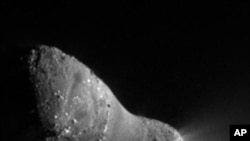Scientists say a NASA spacecraft took photographs of a comet from a distance of only 700 kilometers Thursday, immediately yielding new details about that comet. Scientists say even the initial images sent back to Earth are full of great data, and now they must figure out what all the details and data mean.
The Hartley 2 comet was close enough to NASA's Deep Impact spacecraft to give scientists the best extended view of any comet in history. The spacecraft used two telescopes with digital color cameras and an infrared spectrometer to gather detailed information as it flew past the icy, dusty comet.
Scientists say five initial images from the flyby yielded new details about the comet's volume and the gas and dust that spew from its surface. Thousands more images are expected.
The project's lead investigator Michael A'Hearn says scientists are just getting started. "The engineers did a fantastic job of getting us data. Now, we have to make sense of it to advance the science," he said.
To a casual observer's eye, the comet appears to be shaped like a peanut or a bowling pin - wide on its ends and narrower in the middle. NASA says the comet's main body is about two kilometers long and nearly half-a-kilometer wide at its narrowest point. Jets can be seen streaming out of the nucleus.
Ed Weiler, an associate administrator at NASA, spoke to reporters after the flyby. "It wasn't the computer simulation, it was real. It was the Earth seeing this comet close-up for the first time in history. That's fun. Science can be fun - just as much fun as a computer game, but probably a lot more important to our society," he said.
The U.S. space agency says it is important to study comets because astronomers theorize they are part of a collection of gas, ice, rocks and dust that formed the outer planets of our solar system about 4.5 billion years ago.
This was the fifth time that a spacecraft has been close enough to photograph a comet's core.
NASA Spacecraft Reveals Comet Close-Up






